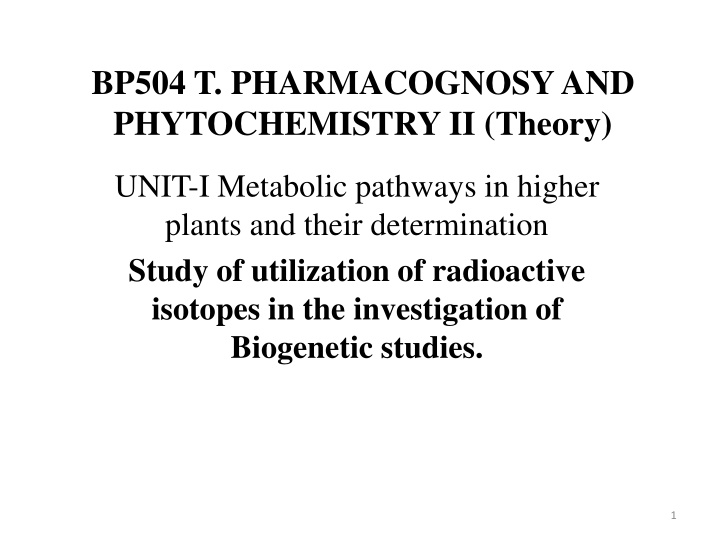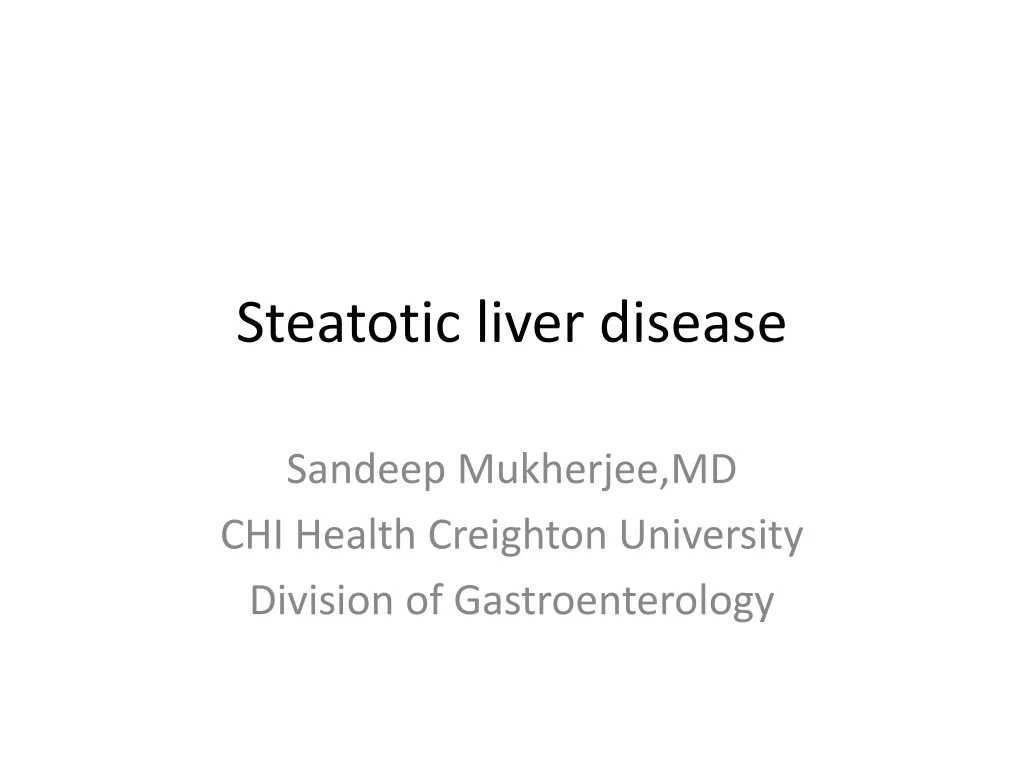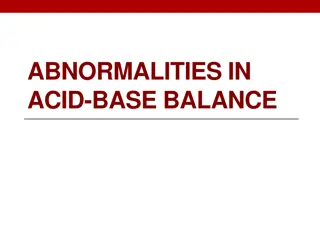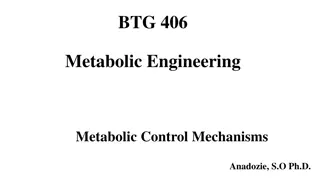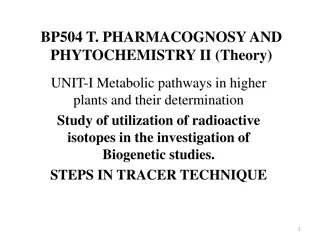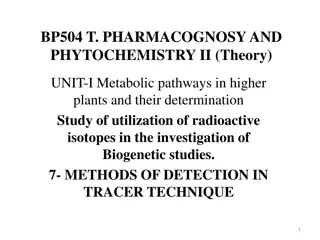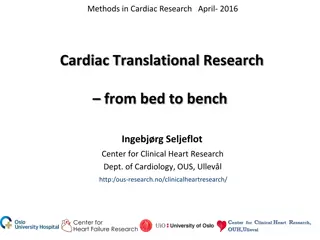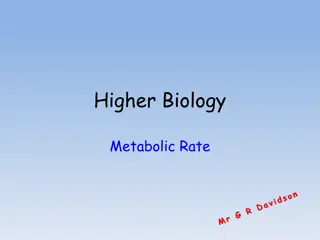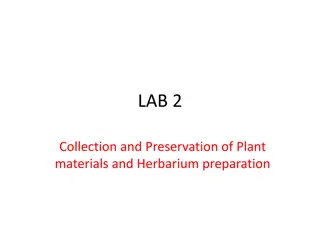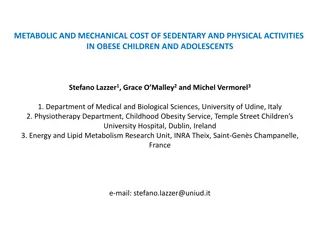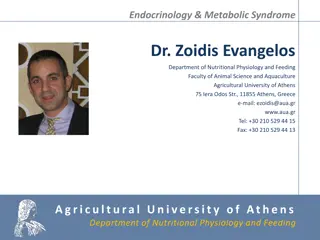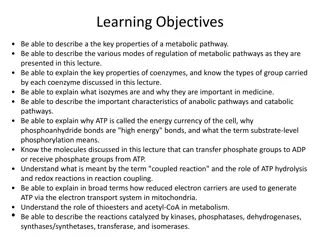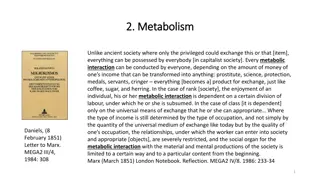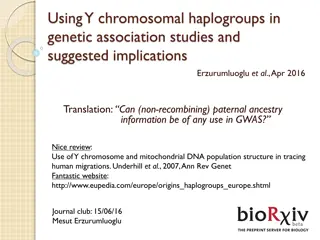Techniques for Investigating Plant Metabolic Pathways and Biogenetic Studies
This content explores various techniques used in pharmacognosy and phytochemistry to investigate the metabolic pathways in plants and study the formation of primary and secondary metabolites. Methods such as utilizing radioactive isotopes, tracer techniques, isolated organs/tissues, grafting, and mutant strains are discussed for elucidating biosynthetic pathways in plants. Examples from the study of compounds like digoxin and reserpine are provided to showcase practical applications of these techniques.
Download Presentation

Please find below an Image/Link to download the presentation.
The content on the website is provided AS IS for your information and personal use only. It may not be sold, licensed, or shared on other websites without obtaining consent from the author.If you encounter any issues during the download, it is possible that the publisher has removed the file from their server.
You are allowed to download the files provided on this website for personal or commercial use, subject to the condition that they are used lawfully. All files are the property of their respective owners.
The content on the website is provided AS IS for your information and personal use only. It may not be sold, licensed, or shared on other websites without obtaining consent from the author.
E N D
Presentation Transcript
BP504 T. PHARMACOGNOSY AND PHYTOCHEMISTRY II (Theory) UNIT-I Metabolic pathways in higher plants and their determination Study of utilization of radioactive isotopes in the investigation of Biogenetic studies. 1
Study of utilization of radioactive isotopes in the investigation of Biogenetic studies Means how the primary and secondary metabolites are formed in the plants (bio) Elucidation of biosynthetic pathways Digitalis- digoxin, Rauwolfia - reserpine etc. Techniques for Tracer techniques investigation Use of Isolated organs or Tissues Grafting method Use of mutant strains Enzymatic studies 2
Techniques for investigating Biogenetic pathways i) Using Isolated Organ/Tissues: This method is based on using isolated parts of plant (eg. Stem, roots etc.). ii) parenchymatous tissue of shoots, leaves, roots Useful in determination of site of synthesis of particular compound. Ex.: Roots and Leaves for study of Nicotiana and Datura, Petal disc for study of oil of rose, Tropane Alkaloids formed in roots of Solanaceae Family. Isolated shoots, and leaves can be maintained in a suitable sterile medium for the studies on Nicotiana and Datura spp. In such types of studies on rooted leaves to get large organization of roots facilitates the study of the tobacco alkaloid, for their biogenetic sites which is generally considered to be roots. 3
Techniques for investigating Biogenetic pathways ii) Grafting methods: Grafting is an operation in which two cut surfaces of different but closely related plants placed so as to unite and further grow together. The major part of plant which is used for grafting is a stock. The portion that is cut off from another plant is called as scion used for study of alkaloid formation by Grafted Plants. Ex.: Tomato Scions grafted on stock datura-accumulate tropane alkaloids, while Datura Scion grafted on Tomato - contained very small amount of Alkaloids. This suggests that main site for formation of Datura Alkaloids is Root & not other organs of datura 4
Techniques for investigating Biogenetic pathways iii) Use of mutant strains: Mutant strains of lower plants like fungi and microorganisms are produced in nature which lacks one or other enzyme because of which the normal metabolic pathways are gently affected. In such mutant strains metabolites are found at the intermediate stage and needs artificial supply of another intermediate. Such mutant strains can be used in the biosynthetic studies of the natural products. 5
Techniques for investigating Biogenetic pathways The biogenetic pathways of the gibberellins are mostly similar in both higher plants and Gibberella fugikuroi. The mutant strains Gibberella can be used to obtain variety of novel C20 isoprenoid compounds which are produced at level of geranyl pyrophosphate in mevalonic acid pathway. These mutant strains can produce amino acids of diverse nature. When the rye plant is introduced with the spore culture of these mutant strains. The sclerocia produced demonstrate the blockages of biogenetic pathway of certain intermediates and there by the accumulation of specific alkaloids (ergot alkaloid) is blocked. 6
Tracer Technique in the investigation of Biogenetic studies Tracer technique: This technique utilises labelled compound to find out/ trace different intermediates & various steps in Biosynthetic Pathway Radio tracer technique: Technique using radio labelled isotopes to find or to trace various precursors & intermediates involved at different stages of biosynthetic pathway at given rate & given time Radiolabelled tracers: These are the compounds when one or more atom of a chemical compound is replaced by radioisotopes used for the study of biosynthetic pathway are known as radio tracers 7
Tracer Technique in the investigation of Biogenetic studies When these labeled compounds are administered into the plants, they become a part of general metabolic pool and undergo reactions characteristic to the metabolism of that particular plant. SIGNIFICANCE OF TRACER TECH. Tracing of biosynthetic pathway -by incorporating radioactive isotopes into the precursor or starting material. E.g. By incorporation of C14 to phenylalanine, the biosynthesis of cynogenetic glycoside, prunacin can be traced. Location and quantity of the compound can be determined in biological system. If location and quantity of glucose is determined in a biological system C14 labeled glucose may be used. The labeled glucose being chemically indistinguishable from native glucose, will mix completely with available glucose polls in the body of organism studied. Both location and quantity of glucose present in tissues can then be determined by radioactive assay. 8
Significance Of Tracer Tech. Different tracer element for different studies: For studies on Protein, alkaloid and amino acid: nitrogen atom gives more specific information than carbon atom. For studies on glycosidic linkage: O, N, S, and C atom. For studies on Terpenoids: O-atom Criteria for tracer techniques: The starting concentration must be sufficient so as to withstand resistance with dilution in course of metabolism. The labeled compound must be involved in synthesis reaction. The labeled compound must be harmless to system to which it is used. Proper labeling is required. For proper labeling physical and chemical nature of compound must be known The tracer should be highly pure. The radioactive isotope with greater halflife period is preferred Ex: 10C - 11C -8.8 Sec to 20mins 14C about 5000 years so it is preferred. 9
Tracer Technique Some Basics on Radioactive isotopes: Isotopes : isos- equal, topos- place- same place, means different isotopes of same element occupy same place in periodic table Same atomic no. but different atomic weight Ex: 12C, 13C, 14C 3 isotopes of C- no. of proton is 6 in each but no. of neutrons vary- i.e. 6,7, & 8 Atomic wt.= N + P (at. no.) Another ex. Hydrogen- 1Proton 1 P + 1N 1P +2N 1H- hydrogen, 2H-deuterium, 3H- tritium 10
Study of utilization of radioactive isotopes in the investigation of Biogenetic studies Two types of isotopes are there 1. Radioactive isotopes (Radioisotopes)- Radioisotopes- Radio- Radiation, emits radiation, unstable isotopes. Radioisotopes are radioactive atoms, with high energy i.e. radiation and release energy emits , , & particles i.e. Decay with emission of radiation , , & forms to achieve stable form Ex. 3H ( ), 14C ( ), 35S ( ), 131I ( ), 24Na are unstable. 2. Stable isotopes- ex. 2H, 13C, 15N, O18- do not emit radiations. Scarcely available, 11
Radiotracers Radiotracers are used to trace the biosynthetic path followed by labeling the atom with radioisotopes i.e. presumed precursor if transferred to different intermediates and product also Radioactivity showed, confirms that the labeled precursor molecule has been utilized for biosynthesis or not Radiotracers : are 1 or more atoms of presumed precursors which are replaced by radioisotopes (2H,14C,35S) Used as markers in biosynthetic studies A* B* C* D* 12
